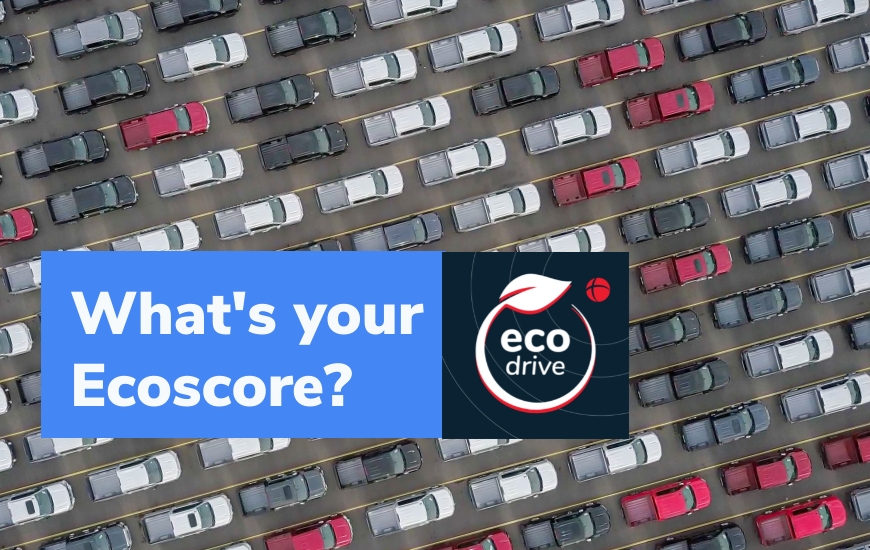The ecoscore makes it easy to find out. A number between 0 and 100 makes it possible to measure the ecological character of a vehicle. For this score multiple categories as global warming, air quality and noise are taken into account. The higher a vehicle scores, the more environmentally friendly it is.
The ecoscore is also a handy indicator for comparing vehicles. Vehicles with different fuels and different technologies can be compared with each other this way.
By entering some data on the government website ecoscore.be, you get to know the average ecoscore of your fleet, as well as the average and total CO2 emissions.
The difference between Ecoscore and CO2 emission
Currently, the CO2 emissions are always mentioned for new cars. And they pop up in advertisements as well. Some manufacturers market ‘environmentally friendly cars’ that emit fewer CO2. These CO2 emissions however, don’t tell us anything about the other emission types like particulates. This concludes that a car with a low CO2 emission level is therefore not necessarily an environmentally friendly vehicle. On top of CO2, Ecoscore further takes into account the other emissions, and therefore provides a broader picture.
The difference between Ecoscore and Euro standard
For a new car to come to the market it has to meet certain conditions. Europe therefore enforces certain restrictions on the vehicle regarding emissions of NOx, CO, hydrocarbons and particulate matter. Every time these “euro standards” become stricter they are given a higher number. We now have euro 6 but in 2024 euro 7 will be enforced, which will be stricter than the one before.
But also these restrictions do not provide an overall picture on how environmentally friendly the car is. This is because it does not take CO2 emissions into account. There is also a difference between petrol and diesel cars, as these cars with the same euro standard are not equally environmentally friendly. Even when cars have the same fuel type and the same standard, there can be a difference in environmentally friendliness in these cars. The Ecoscore takes all these differences into account and provides a more general evaluation of the car and its environmentally friendliness than the euro standards.
How do they calculate the Ecoscore?
The calculations of the Ecoscore are based on two elements. The emissions of a vehicle when it is in use and the emissions generated during the production and transport of the fuel.
This is subdivided into 3 categories:
- Emissions that have an impact on the greenhouse effect (carbon dioxide, methane and nitrogen oxide),
- Emissions that affect air quality (carbon monoxide, hydrocarbons, nitrogen oxides, particulate matter, sulphur dioxide) and
- Noise emissions (engine noise expressed in decibels)
The following pollutants are taking in account when calculating the air quality emissions:
Particulate matter (PM), Carbon monoxide (CO), Sulfur dioxide (SO2), Hydrocarbons (HC) and Nitric oxides (NOx)
Is the production and recycling phase of the vehicle taken into account when calculating the ecoscore?
There is little knowledge about the production and recycling phase of vehicles, and most definitely not about all vehicles available on the market. Therefore, vehicles for which this information is not available, logically do not result in an accurate Eco score. When we then take in account that studies show that the pollutants emitted during the well-to-wheel phase make up for 90% of the total environmental impact, it’s better simply not to include these phases to the Eco score.
What does the Ecoscore say about a vehicle?
The Ecoscore provides a number between 0 and 100. How higher the number, how environmentally friendlier the car is. Therefore, a vehicle with an ecoscore lower than 50 is very polluting, vehicles with a score higher than 70 are considered environmentally friendly and between 50 and 70 are the middle: vehicles that are not ecological, but also not very polluting.
What information do you need to calculate the score?
We can separate the data needed for calculating the eco score. This data can come from different sources. The distinction we make is between direct and indirect emissions, as well as between recent and old vehicles.
Recent vehicles
Direct emissions
There is a clear relationship between emissions and the use phase (age- and wear-related) of a vehicle. There are 3 parts to the pollutants emitted while driving with the vehicle:
- The first part is the emissions depending on engine technology,
- another part is what is measured during the official approval tests of a vehicle that they have to undergo before it can enter the market,
- and a third part is fuel consumption and fuel type.
The first and third are two groups of data originating from European studies or can be derived from the composition of the fuel used.
The Ecoscore is based on the registrations of new vehicles at the DIV AND on the data of new models from Autovista Group (formerly known as EurotaxGlass). The reason for that is that models are first available in the catalogue before they are registered at the DIV. Ecoscore updates its database every 2 months. Thus, it is rare that a new car model would not be available on Ecoscore’s website.
Indirect emissions
Indirect emissions are those associated with the production and distribution of the fuel the vehicle uses. Of course, these levels depend on the fuel consumption and fuel type of the vehicle: the more a vehicle consumes, the more fuel it will need to be produced and the greater the emission of pollutants will be.
Old vehicles
Less emission data are available from the approval tests for all vehicles dating from before 2002. Therefore, Ecoscore has to work with estimations and assumptions for these vehicles regarding (CO2) emissions and fuel consumptions.
Where can the data be found to calculate the Ecoscore for cars?
The Certificate of Conformity (COC) is a document proving that the produced type of vehicle at the time of its production fulfils all the technical requirements needed. Simply use the information provided on this document to calculate the Ecoscore via the calculator tool.
Pay attention: Depending on the brand of the car, the emission data used in the certificate of conformity may differ from the data required in the calculator.
An accurate Eco score isn’t just linked to the tech specs of a vehicle… but also to the behaviour of the driver.
Extra tips to drive more ecologically
Additionally to the vehicle’s technical details and the fuel that the car is using, there are many other things that one can do to drive more ecologically:
- Regularly check and adjust the tyre pressure. When the tyre pressure is too low, your car will use more fuel.
- Regular maintenance on your vehicle.
- Limit the use of air conditioning. Many drivers use their airco when it is not necessary or open their windows while using their it. Air conditioning consumes fuel and its use is often unnecessary.
- Drive smooth, slow and safe.

Keep track of your drivers’ behaviour
If you work with trucks (or other motorized vehicles), fuel consumption is a big cost for your company. Suivo offers you the tools you need to perform a thorough driving style analysis of your drivers.
Suivo goes a big step further than the Eco scores described above: the eco score in the Suivo module also takes into account the driving behavior of the driver, in stead of just the tech specs of the vehicle. When these analyses become visible to the drivers themselves, they are often amazed at what they can personally do to reduce their ecological footprint.
At first, the Eco Drive module was only visible on the Suivo IoT Cloud platform, but from now on you increase the involvement of the drivers thanks to a user-friendly app. They can consult the results of their driving analyses on any smart device. This way you stimulate your drivers to drive economically and safely.
The Suivo Eco Drive module is a licensed-based tool. Do you want to know how it works? Ping us to advise you!
More inspiration on ecological driving:
Blog & Webinar Eco Driving: Ecological & safe
Blog Track & Trace: Eco-scoring for drivers






